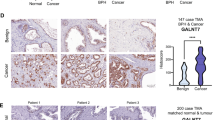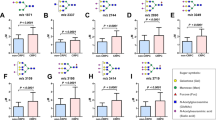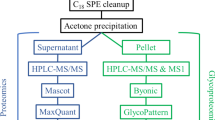Abstract
Background:
The enzyme arylsulfatase B (ARSB; N-acetylgalactosamine-4-sulfatase) degrades chondroitin-4-sulfate (C4S) and is reduced in malignant colonic and mammary tissues but has not previously been evaluated in prostate cancer.
Methods:
ARSB immunostaining was performed on two tissue microarrays (TMAs) and analyzed by digital image analysis, generating ARSB H-scores for prevalence and intensity of epithelial, stromal and combined epithelial and stromal immunostaining. Also, paired malignant and normal prostate tissues were analyzed for ARSB activity, C4S, total sulfated glycosaminoglycans and versican content. The quantities of C4S and of the epidermal growth factor receptor (EGFR) that co-immunoprecipitated with versican were determined in the normal and malignant paired prostate tissues.
Results:
Forty-four cases of prostate cancer were paired by age (±5 years), race, Gleason score (in order) and pathological TNM (tumor, node, metastasis) score. The pairs differed by recurrence vs non-recurrence of elevated PSA at ⩾4 years. When TMA cores were analyzed for ARSB H-score, 18 of the 22 pairs had lower ARSB H-scores in the recurrent member of the pair, whereas higher initial PSA values were associated with recurrence in only 65% of the paired cases. In a second TMA, Gleason scores 6 and 7 were associated with higher ARSB H-scores than Gleason scores 8 and 9 for stroma, epithelium and stroma and epithelium combined (P=0.052, P=0.015, P<0.0001, respectively) and were inversely correlated (r=−0.98, −0.97 and −0.99, respectively). In other paired normal and malignant prostate tissues, ARSB activity was significantly higher in the normal tissues, and C4S and versican values were lower (P<0.0001). C4S that co-immunoprecipitated with versican was greater in the malignant than in the normal tissue, whereas total EGFR that co-immunoprecipitated with versican was reduced.
Conclusions:
Study findings suggest that ARSB may be useful as a prognostic biomarker in prostate cancer and that the biological action of ARSB on chondroitin sulfate may impact upon versican’s effects in the tumor microenvironment.
This is a preview of subscription content, access via your institution
Access options
Subscribe to this journal
Receive 4 print issues and online access
$259.00 per year
only $64.75 per issue
Buy this article
- Purchase on Springer Link
- Instant access to full article PDF
Prices may be subject to local taxes which are calculated during checkout





Similar content being viewed by others
References
Glaser JH, Conrad HE . Chondroitin SO4 catabolism in chick embryo chondrocytes. J Biol Chem 1979; 254: 2316–2325.
deSousa Júnior JF, Nader HB, Dietrich CP . Sequential degradation of chondroitin sulfate in molluscs. J Biol Chem 1990; 265: 20150–20155.
Prabhu SV, Bhattacharyya S, Guzman-Hartman G, Macias V, Kajdacsy-Balla A, Tobacman JK . Extra-lysosomal localization of arylsulfatase B in human colonic epithelium. J Histochem Cytochem 2011; 59: 328–335.
Bhattacharyya S, Solakyildirim K, Zhang Z, Linhardt RJ, Tobacman J . Chloroquine reduces arylsulfatase B activity and increases chondroitin 4-sulfate: Implications for mechanisms of action and resistance. Malaria J 2009; 8: 303.
Bhattacharyya S, Solakyildirim K, Zhang Z, Linhardt RJ, Tobacman JK . Cell-bound IL-8 increases in bronchial epithelial cells following Arylsulfatase B silencing. Am J Respir Cell Mol Biol 2010; 42: 51–61.
Mitsunaga-Nakatsubo K, Kusunoki S, Kawakami H, Akasaka K, Akimoto Y . Cell-surface arylsulfatase A and B on sinusoidal endothelial cells, hepatocytes, and Kupffer cells in mammalian livers. Med Mol Morphol 2009; 42: 63–69.
Bhattacharyya S, Tobacman JK . Hypoxia reduces arylsulfatase B activity and silencing arylsulfatase B replicates and mediates the effects of hypoxia. PLoS One 2012; 7: e33250.
Bhattacharyya S, Kotlo K, Shukla S, Danziger RS, Tobacman JK . Distinct effects of N-acetylgalactosamine-4-sulfatase and galactose-6-sulfatase expression on chondroitin sulfate. J Biol Chem 2008; 283: 9523–9530.
Bhattacharyya S, Tobacman JK . Arylsulfatase B regulates colonic epithelial cell migration by effects on MMP9 expression and RhoA activation. Clin Exp Metastasis 2009; 26: 535–545.
Bhattacharyya S, Tobacman JK . Steroid sulfatase, arylsulfatases A and B, galactose 6-sulfatase, and iduronate sulfatase in mammary cells and effects of sulfated and non-sulfated estrogens on sulfatase activity. J Steroid Biochem Mol Biol 2007; 103: 20–34.
Ricciardelli C, Mayne K, Sykes PJ, Wyaymond WA, McCaul K, Marshall VR et al. Elevated stromal chondroitin sulfate glycosaminoglycan predicts progression in early-stage prostate cancer. Clin Cancer Res 1997; 3: 983–992.
Ricciardelli C, Mayne K, Sykes PJ, Raymond WA, McCaul K, Marshall VR et al. Elevated levels of versican but not decorin predict disease progression in early-stage prostate cancer. Clin Cancer Res 1998; 4: 963–971.
Ricciardelli C, Sakko AJ, Ween MP, Russell DL, Horsfall DJ . The biological role and regulation of versican levels in cancer. Cancer Metastasis Rev 2009; 28: 233–245.
Wu YJ, La Pierre DP, Wu J, Yee AJ, Yang BB . The interaction of versican with its binding partners. Cell Res 2005; 15: 483–494.
Sakko AJ, Ricciardelli C, Mayne K, Suwiwat S, LeBaron RG, Marshall VR et al. Modulation of prostate cancer cell attachment to matrix by versican. Cancer Res 2003; 63: 4786–4791.
Bhattacharyya S, Feferman L, Tobacman JK Galectin-3 and AP-1 mediate transcriptional effect of Arylsulfatase B (N-acetylgalactosamine-4-sulfatase) on versican in prostate cancer. AACR 2013: 13-A-4020-AACR.
Schröder FH, Hugosson J, Roobol MJ, ERSPC Investigators. Prostate-cancer mortality at 11 years of follow-up. N Engl J Med 2012; 366: 981–990.
Makarov DV, Loeb S, Getzenberg RH, Partin AW . Biomarkers for prostate cancer. Annu Rev Med 2009; 60: 139–151.
Kajdacsy-Balla A, Geynisman JM, Macias V, Setty S, Nanaji NM, Berman JJ et alCooperative Prostate Cancer Tissue Resource. Practical aspects of planning, building, and interpreting tissue microarrays: the cooperative prostate cancer tissue resource experience. J Mol Histol 2007; 38: 113–121.
Ananthanarayanan V, Deaton RJ, Amatya A, Macias V, Luther E, Kajdacsy-Balla A et al. Subcellular localization of p27 and prostate cancer recurrence: automated digital microscopy analysis of tissue microarrays. Hum Pathol 2011; 42: 873–881.
BlyscanTM sulfated GAG assay. Bio.Bly.VER.03-12March2012int. www.biocolor.co.uk. Accessed 6/11/2012.
Sheng W, Wang G, Wang Y, Liang J, Wen J, Zheng PS et al. The roles of versican V1 and V2 isoforms in cell proliferation and apoptosis. Mol Biol Cell 2005; 16: 1330–1340.
Miquel-Serra L, Serra M, Hernández D, Domenzain C, Docampo MJ, Rabanal RM et al. V3 versican isoform expression has a dual role in human melanoma tumor growth and metastasis. Lab Invest 2006; 86: 889–901.
Du WW, Yang BB, Shatseva TA, Yang BL, Deng Z, Shan SW et al. Versican G3 promotes mouse mammary tumor cell growth, migration, and metastasis by influencing EGF receptor signaling. PLoS One 2010; 5: e13828.
Zheng PS, Wen J, Ang LC, Sheng W, Viloria-Petit A, Wang Y et al. Versican/PG-M G3 domain promotes tumor growth and angiogenesis. FASEB J 2004; 18: 754–756.
Hernandez D, Miquel-Serra L, Docampo M-J, Marco-Ramell A, Cabrera J, Fabra AS et al. V3 versican isoform alters the behavior of human melanoma cells by interfering with CD44/ErbB-dependent signaling. J Biol Chem 2011; 286: 1475–1485.
Kischel P, Waltregny D, Dumont B, Turtoi A, Greffe Y, Kirsch S et al. Versican overexpression in human breast cancer lesions: known and new isoforms for stromal tumor targeting. Int J Cancer 2010; 126: 640–650.
Rajan R, Vanderslice R, Kapur S, Lynch J, Thompson R, Djakiew D . Epidermal growth factor (EGF) promotes chemomigration of a human prostate tumor cell line, and EGF immunoreactive proteins are present at sites of metastasis in the stroma of lymph nodes and medullary bone. Prostate 1996; 28: 1–9.
Perry JE, Grossmann ME, Tindall DJ . Epidermal growth factor induces Cyclin D1 in a human prostate cancer cell line. Prostate 1998; 35: 117–124.
Festuccia C, Angelucci A, Gravina GL, Biordi L, Millimaggi D, Muzi P et al. Epidermal growth factor modulates prostate cancer cell invasiveness regulating urokinase-type plasminogen activator activity. Thromb Haemost 2005; 93: 964–975.
Harmatz P, Giugliani R, Schwartz IV, Guffon N, Teles EL, Miranda MC et alMPS VI Study Group. Long-term follow-up of endurance and safety outcomes during enzyme replacement therapy for mucopolysaccharidosis VI: final results of three clinical studies of recombinant human N-acetylgalactosamine 4-sulfatase. Mol Genet Metab 2008; 95: 469–475.
Acknowledgements
We appreciate the contributions of Andrew Hall, Virgilia Macias, and Klara Valyi-Nagy to the procurement and immunostaining of prostate tissues. Funding was by VA Merit Review and UIC CCTS ULI RR029879 pilot award to JKT.
Author information
Authors and Affiliations
Corresponding author
Ethics declarations
Competing interests
The authors declare no conflict of interest.
Rights and permissions
About this article
Cite this article
Feferman, L., Bhattacharyya, S., Deaton, R. et al. Arylsulfatase B (N-acetylgalactosamine-4-sulfatase): potential role as a biomarker in prostate cancer. Prostate Cancer Prostatic Dis 16, 277–284 (2013). https://doi.org/10.1038/pcan.2013.18
Received:
Revised:
Accepted:
Published:
Issue Date:
DOI: https://doi.org/10.1038/pcan.2013.18
Keywords
This article is cited by
-
Reformation of the chondroitin sulfate glycocalyx enables progression of AR-independent prostate cancer
Nature Communications (2022)
-
Restriction of Aerobic Metabolism by Acquired or Innate Arylsulfatase B Deficiency: A New Approach to the Warburg Effect
Scientific Reports (2016)
-
Arylsulfatase B regulates versican expression by galectin-3 and AP-1 mediated transcriptional effects
Oncogene (2014)



